Building the AI Team & Culture: Your Blueprint for Sustainable Innovation
If your organization is serious about capturing the true value of AI—whether that means automating repetitive processes, opening new revenue channels, or redefining customer experiences—you’ll need more than advanced models and pristine datasets. Success requires an AI-ready team, a culture that encourages experimentation, and a governance structure that ensures every initiative aligns with the company’s strategic direction.
In this post, we’ll explore:
- Why the right team matters
- The pain of skills gaps and cultural resistance
- How to forge cross-functional alliances
- Upskilling and hiring strategies for crucial AI roles
- The key insight that ties it all together
Let’s dive in—and by the end, you’ll have a clear, practical roadmap to build an AI-driven organization that thrives.
Key Topics
- The Critical Role of an AI Center of Excellence
- Overcoming the Skills Gap & Resistance to Change
- Aligning Departments Around Shared AI Goals
- Balancing Internal Upskilling with Strategic Hiring
- Cultivating a Data-Driven, Collaborative Culture
Why The Right Team Matters
Picture two organizations. One launches its AI initiatives with a dedicated Center of Excellence, appoints AI champions inside every business unit, and deploys cross-trained, “full-stack” squads capable of bridging data science, engineering, and operations. The other leaves AI to a small, isolated group of data scientists—disconnected from the business context—while marketing, operations, and frontline teams are left in the dark. Which company do you think scales pilots into meaningful production systems? The answer is self-evident.
A well-run Center of Excellence (CoE) becomes the nerve center of your AI strategy. It codifies best practices, builds governance frameworks, and develops reusable tools, models, and code libraries. By eliminating the need for every project team to start from scratch, the CoE accelerates deployment speed while instilling confidence and consistency across the enterprise.
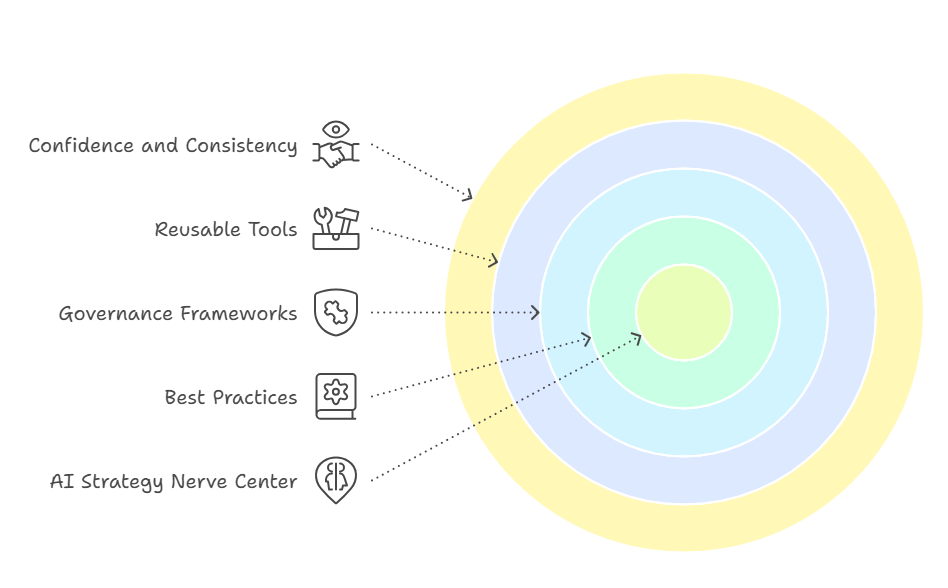
Meanwhile, AI Champions embedded within each department act as translators and advocates. They connect technical experts with business stakeholders, showcase early wins, and translate complex results into language that resonates with executives and front-line teams alike. This keeps momentum alive and ensures AI adoption is not just a technical initiative but an enterprise movement.
Finally, Full-Stack AI Teams— Bringing together data engineers, data scientists, ML engineers, UX designers, and product managers into cross-functional squads ensures that every stage of the AI lifecycle—data ingestion, model development, deployment, and feedback loops—is tightly coordinated. Nothing falls through the cracks.
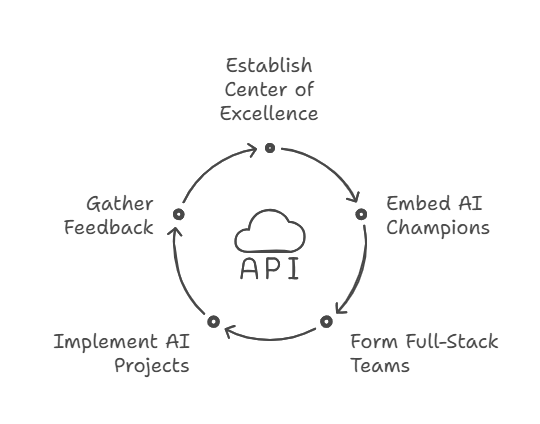
Overcoming Skills Gaps & Resistance in Your AI Team and Culture
Even the strongest AI vision can stall if the organization lacks the expertise to carry it forward. Many companies hire a few data scientists, only to realize later that deploying AI at scale requires far more: software engineers to productionize models, DevOps and MLOps specialists to manage infrastructure, and operations teams capable of maintaining models reliably in live environments. Without these supporting capabilities, even the most sophisticated models remain stuck in proof-of-concept purgatory.

Equally challenging is the cultural resistance that often shadows AI adoption. Veteran employees may quietly fear that automation equates to job cuts. Others may assume that embracing AI demands overnight fluency in Python or advanced data science. Left unaddressed, these concerns quickly translate into slow adoption, half-hearted participation, or outright resistance.
The result is a double bind: skills gaps and cultural friction converge, creating organizational tension. Senior leadership sees the transformative potential of AI, but middle management and frontline teams hesitate to commit the time, effort, and mindset shifts required. Too often, this leads to promising pilots that stall or never graduate into production—fueling executive skepticism and eroding confidence in future AI investments.
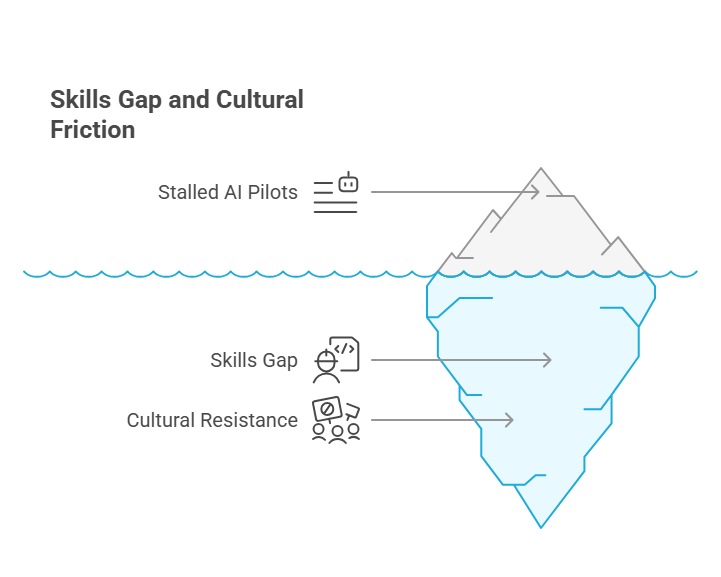
Functional Alliances for AI Team and Culture
To break down these barriers, start by aligning every stakeholder behind clear business goals. Before you write any code or configure any platform, gather decision-makers from finance, operations, marketing, and IT to agree on the top one or two objectives—whether that’s reducing customer churn by 10%, cutting support costs by 20%, or increasing lead-to-opportunity conversion by 15%.
The next step is to embed business objectives directly into your CoE’s project intake process. Every proposed AI initiative should be evaluated not only on technical merit, but on its alignment with measurable business outcomes. When a data scientist proposes a new NLP model, for example, the pitch should frame the impact in terms of a shared metric—“this reduces manual review time by 20%”—rather than simply emphasizing the novelty of the technology. This discipline ensures that AI remains a driver of enterprise value, not just a playground for experimentation.

Equally important is appointing AI Champions within each department, with a direct reporting line to the CoE. These champions translate enterprise AI strategy into department-level priorities—whether it’s marketing applying sentiment analysis to sharpen campaign messaging, or finance deploying anomaly detection to identify fraudulent invoices earlier. By fostering momentum, fielding peer questions, and spotlighting quick wins, champions make AI adoption tangible and inclusive, building trust and enthusiasm across the organization.
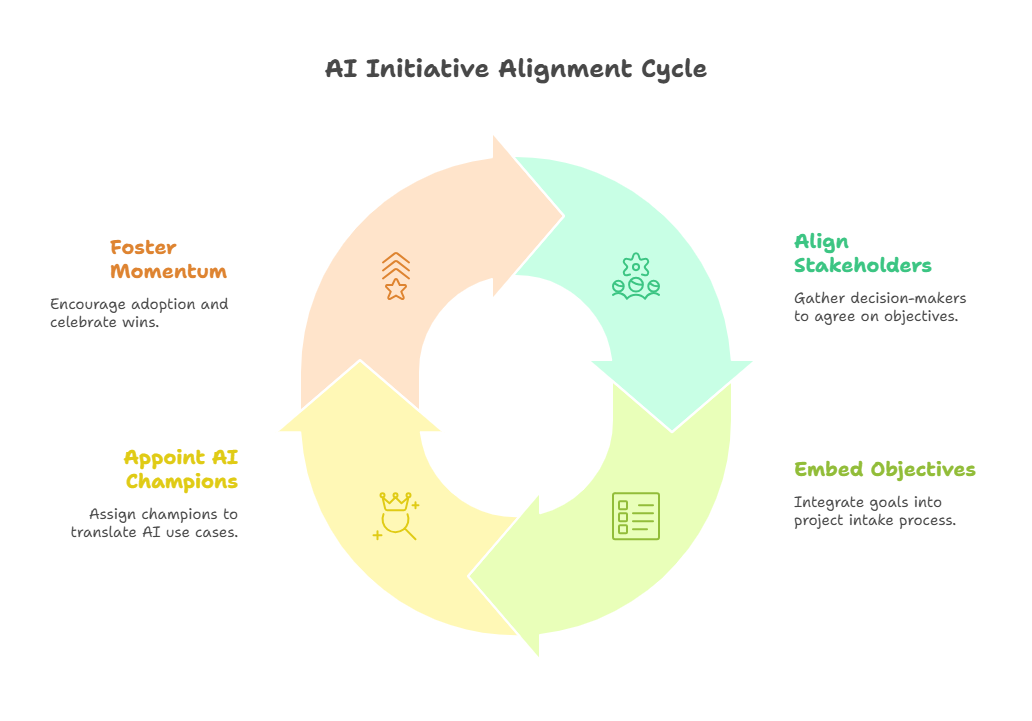
Upskilling & Hiring Strategies
While strategic hiring is essential to close high-priority gaps, don’t underestimate the goldmine already within your walls: your existing workforce. Upskilling and cross-training current employees not only accelerates capability-building but also reduces resistance by showing teams they have a future in the AI-enabled organization.
The most effective strategy is a balanced approach—filling specialized roles through targeted hiring while simultaneously investing in your people. Here’s how to strike that balance
Internal Training Programs
Launch hands-on bootcamps that pair data scientists with domain experts. Have participants work on real company data under guided mentorship, reinforcing both technical and contextual knowledge. Offer micro-learning modules on ML fundamentals, MLOps, and data ethics—so non-technical staff can gain working familiarity without needing to become full-time coders.

External Partnerships
Collaborate with universities or specialized training providers to create bespoke courses tailored to your industry challenges. Sponsor apprenticeships and internships to bring in emerging talent hungry to prove themselves within your organization.
Targeted Hiring
Identify the one or two roles you absolutely cannot train internally—perhaps a seasoned ML engineer or an MLOps architect—and recruit selectively for those positions. Emphasize “full-stack AI” capabilities when screening candidates: look for people who understand not just model development, but also data pipelines, APIs, and production deployment.
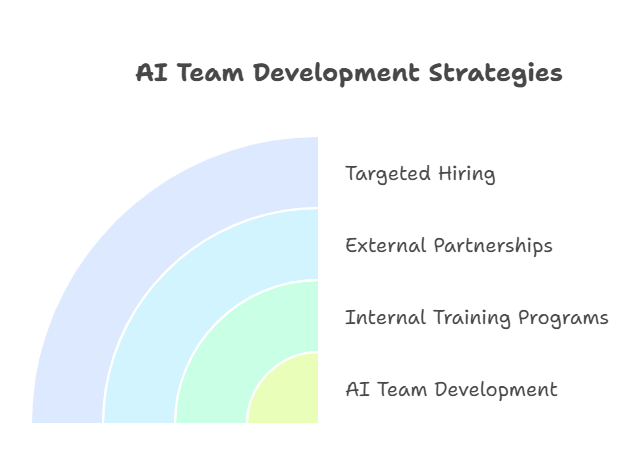
By upskilling where feasible and hiring strategically where necessary, you build a resilient talent pipeline that knows your business inside-out, while still injecting new expertise at the right junctures.
Cultivating a Data-Driven, Collaborative Culture
At the end of the day, culture trumps strategy when the two are misaligned. You can design the most sophisticated AI roadmap, but if the organization perceives it as just another “IT project” rather than a company-wide priority, its impact will be limited. True transformation happens when AI is woven into the fabric of how the business thinks, decides, and operates.
Here’s how to begin embedding AI into your corporate DNA:
- Transparency & Storytelling: Regularly publish internal case studies—“how we cut processing time by 50% with predictive models”—to show real people benefiting.
- Shared Metrics: Tie AI outcomes to department-level KPIs, so every team feels responsibility and pride in driving the metrics forward.
- Continuous Learning: Host quarterly “AI hackathons” or “data jam sessions” where cross-functional teams brainstorm new use cases and prototype ideas in a low-stakes environment.

When every employee—from sales rep to software engineer—sees that data-driven thinking is rewarded, innovation flourishes organically.
Your Next Steps
- Download the AI Team Blueprint (Free Download)
A step-by-step guide outlining essential roles (data scientist, data engineer, business analyst, etc.), team structures, and collaboration workflows within a Center of Excellence. - Register for our AI Talent Webinar
Join live to see real-world examples of how companies bridged the skills gap, built cross-functional alliances, and scaled AI projects successfully. - Implement Your Key Action Items
- Map your strategic goals to AI use cases.
- Audit current skills and identify training needs.
- Form your Center of Excellence and appoint champions.
- Balance upskilling with targeted hires for specialized roles.
- Launch your first cross-departmental AI hackathon to foster collaboration.
Ready to transform into an AI powerhouse?
Download the AI Team Blueprint now and sign up for our AI Talent Webinar to kick-start your journey. With the right team, culture, and roadmap, you’ll turn ambitious ideas into real business impact.